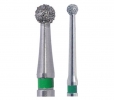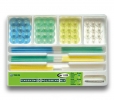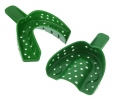The role of micrometer and submicrometer surface roughness on the interaction of cells with titanium model surfaces of well-defined topography was investigated using human bone-derived cells (MG63 cells). The early phase of interactions was studied using a kinetic morphological analysis of adhesion, spreading and proliferation of the cells. By SEM and double immunofluorescent labeling of vinculin and actin, it was found that the cells responded to nanoscale roughness by a higher cell thickness and a delayed apparition of the focal contacts. A singular behavior was observed on nanoporous oxide surfaces, where the cells were more spread and displayed longer and more numerous filopods. On electrochemically microstructured surfaces with hemispherical cavities, arranged in a hexagonal pattern, the MG63 cells were able to go inside, adhere and proliferate in cavities of 30 or 100 microm in diameter, whereas they did not recognize the 10 microm diameter cavities. Cells adopted a 3D shape when attaching inside the 30 microm diameter cavities. Condensation of actin cytoskeleton correlated with vinculin-positive focal contacts on cavity edges were observed on all microstructured surfaces. Nanotopography on surfaces with 30 microm diameter cavities had little effect on cell morphology compared to flat surfaces with same nanostructure, but cell proliferation exhibited a marked synergistic effect of microscale and nanoscale topography.
Source:PMID: 14962549 PubMed - indexed for MEDLINE




